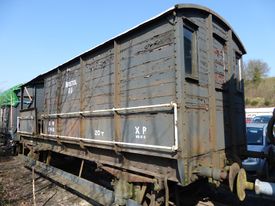GWR 17410 'Toad' 20T Goods Brake Van
| GWR 17410 'Toad' 20T Goods Brake Van | |
|---|---|
 GWR Toad Brake Van 17410 | |
| Built By | GWR Swindon |
| Status | Under restoration |
| Number | 17410 |
| History | |
| Built | 1940 |
| Type | Brake van |
| Telegraphic code | Toad |
| Brakes | Vacuum fitted |
| 1970 | Entered preservation on SVR |
| 2016 | Restoration begun |
Early in its life the sanding gear was removed, and its place was taken by additional ballast. It is believed that the additional adhesion weight would have been of more use to a fitted brake van. Many other preserved vac. fitted Toads have undergone the same modification.
Contents
17140 in preservation
It arrived on the SVR in November 1970, purchased by a group of working members known as the 17410 Fund, and was restored the following year, after which it saw regular use by the PW Department. Following withdrawal as surplus to PW requirements and in very poor condition it languished in Bewdley yard, but in December 2015 its restoration, by the LNER Carriage Group, started. In early 2016 the 17410 Fund transferred ownership to the SVR Charitable Trust for restoration and continued preservation on the SVR.[1] The van is known to many on the SVR as "Don Wilcox's toad". Once restored its hoped to use it as a fitted brake van on demonstration freight trains, filming and photo charters, and for brake van rides, for which it will be most suitable.
2015 restoration
Much progress with its restoration has been made, the continued rate of which will depend largely on the raising of funds for materials. A new pair of veranda side doors and replacement opening window frames have been made, and the end hatch restored. The layers of paint were removed from the interior, when it was found that its first, "as built" internal finish was scumble grained in imitation beech and cedar with a light oak ceiling. The number 17410 was stenciled opposite the guard's seat in pink lettering, with the word "CARDIFF" (presumably its first allocation) below. Its later (presumed BR) interior finish was off white (ivory) and bauxite with a white ceiling. Regular progress reports and detailed pictures are posted on LNER(SVR)Coach Fund Toad Progress Page
Much of the steelwork, the entire wooden floor and most of the side/end/roof planking needs replacing. The tyres need to be turned to remove flats. Vacuum cylinder, brakegear pins and bushes must be refurbished. A new stove and roof canvass will be essential.
It is intended to restore it to as near original condition as reasonably possible, and in GWR livery, but BR bauxite has not been ruled out as a possibility for the future.
During the summer/autumn of 2016, the vacuum brake cylinder and handbrake pedestal were removed to safe storage and the rotten steel veranda sides and underfloor platework were consigned to the scrapheap. A considerable amount of (very necessary) weld repair was then carried out by a skilled volunteer on the exposed section of underframe, ballast bins and bases of the cabin and side door posts.[2][3] A heavy job completed in early October was the emptying, cleaning, strengthening, painting and re-filling of all eight underfloor ballast bins.
New veranda side and end plates,underfloor support plates, kerb rails and corner posts were made and fitted by Mawley Engineering Ltd between 18-20 October 2016 to replace the thoroughly rotten originals. However the very prominent waist level angle irons, the two vertical "T" sections at the end, and the two side door slam posts were in good condition and have been refurbished and re-used. The new structure was seal welded to prolong its life expectancy, but volunteers have commenced the time consuming job of drilling the new steelwork for snap head rivets which will maintain the authentic look.
Fortunately the steelwork at the van sides and end was mostly restorable, and after emptying many broken drawhooks and worn out brake blocks from the sandboxes and ballast bin (under the end windows and hatch), the rust and life expired end section of kerb rail were removed. The floor plate (and hence the end of the body) had been lifted about half an inch by rust scale which was removed prior to the said plate being seam welded to the headstock to prevent a repetition. A replacement kerb rail and floor strengthening angle iron were also welded in place, and the ballast replaced. The steel lower van sides were starting to suffer from rust due to water ingress through the failed seals. A new sealing system is being tried, involving steel angle seam welded to the top inside edge of the original steel plates. It is invisible, saves much "original fabric", and hopefully will improve 17410's longevity. In May 2017 the new floor was installed; made from 3" thick Douglas Fir tongue and groove boards. The planking for the side and roof repairs arrived later that month. By September 2017 both sides and ends had been refurbished with new Douglas Fir planks.
To finance the restoration The SVR Charitable Trust is seeking donations and component sponsorship, both of which can be Gift Aided. A form can be accessed by clicking on the link SVR Charitable Trust TOAD Donation Form.Thank you.
Gallery
See also
References
17410 on the Railway Heritage Register Wagon Survey
SVR Stock Book Eighth Edition
- ↑ Public Notice GWR ‘Toad’ 17410, dated 1 September 2015, accessed 10 November 2015
- ↑ NatPres forum SVR Wagons Thread
- ↑ 17410 restoration updates on www.lnersvrcoachfund.org.uk












